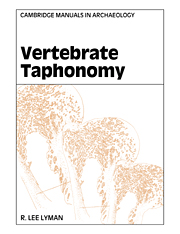Book contents
- Frontmatter
- Dedication
- Contents
- List of figures
- List of tables
- Preface
- Acknowledgements
- 1 WHAT IS TAPHONOMY?
- 2 THE HISTORY AND STRUCTURE OF TAPHONOMY
- 3 TAPHONOMY IN PRACTICE AND THEORY
- 4 STRUCTURE AND QUANTIFICATION OF VERTEBRATE SKELETONS
- 5 VERTEBRATE MORTALITY, SKELETONIZATION, DISARTICULATION, AND SCATTERING
- 6 ACCUMULATION AND DISPERSAL OF VERTEBRATE REMAINS
- 7 FREQUENCIES OF SKELETAL PARTS
- 8 BUTCHERING, BONE FRACTURING, AND BONE TOOLS
- 9 OTHER BIOSTRATINOMIC FACTORS
- 10 BURIAL AS A TAPHONOMIC PROCESS
- 11 DIAGENESIS
- 12 TAPHONOMY OF FISH, BIRDS, REPTILES, AND AMPHIBIANS
- 13 DISCUSSION AND CONCLUSIONS
- Bibliography
- Glossary of taphonomy terminology
- Index
6 - ACCUMULATION AND DISPERSAL OF VERTEBRATE REMAINS
Published online by Cambridge University Press: 05 August 2014
- Frontmatter
- Dedication
- Contents
- List of figures
- List of tables
- Preface
- Acknowledgements
- 1 WHAT IS TAPHONOMY?
- 2 THE HISTORY AND STRUCTURE OF TAPHONOMY
- 3 TAPHONOMY IN PRACTICE AND THEORY
- 4 STRUCTURE AND QUANTIFICATION OF VERTEBRATE SKELETONS
- 5 VERTEBRATE MORTALITY, SKELETONIZATION, DISARTICULATION, AND SCATTERING
- 6 ACCUMULATION AND DISPERSAL OF VERTEBRATE REMAINS
- 7 FREQUENCIES OF SKELETAL PARTS
- 8 BUTCHERING, BONE FRACTURING, AND BONE TOOLS
- 9 OTHER BIOSTRATINOMIC FACTORS
- 10 BURIAL AS A TAPHONOMIC PROCESS
- 11 DIAGENESIS
- 12 TAPHONOMY OF FISH, BIRDS, REPTILES, AND AMPHIBIANS
- 13 DISCUSSION AND CONCLUSIONS
- Bibliography
- Glossary of taphonomy terminology
- Index
Summary
What are all these bones doing here?
(P. Shipman 1979:42)Introduction
Paleontologists and zooarchaeologists tend to be optimal foragers when choosing a place to collect faunal remains. For the former, it saves time and money. For the latter, it not only saves time and money, but the places chosen are usually selected by an archaeologist because they contain a dense concentration of artifacts; if bones are spatially associated with the artifacts, then they too are usually collected (because they are there and) regardless of their frequency per unit volume of sediment. Typically, few archaeological sites are excavated or collected simply because they contain animal remains. Determining how the animal remains came to be in the locations from which they are collected, regardless of their geographical and geological position when collected, is one of the most fundamental aspects of taphonomic research.
Why are bones densely concentrated in a particular location, but not in surrounding areas? Why are some kinds of bones present or abundant and other kinds absent or rare? Why are some skeletons completely articulated, some partially articulated, and others totally disarticulated? Why are some bones spatially close and others spatially distant from one another? Why are some bones oriented one way and others oriented another way? Why do some assemblages have lots of carnivore remains and others have few relative to the frequency of herbivore remains? This sampling of questions implies a number of variables that might be measured in an analysis of accumulation.
- Type
- Chapter
- Information
- Vertebrate Taphonomy , pp. 161 - 222Publisher: Cambridge University PressPrint publication year: 1994
- 1
- Cited by

